12th Annual Pallet Report: Wood pallets continue to reign
Our annual Peerless Research Group study highlights the current and projected use of pallets in fulfillment centers plus other trends taking place in the pallet market.
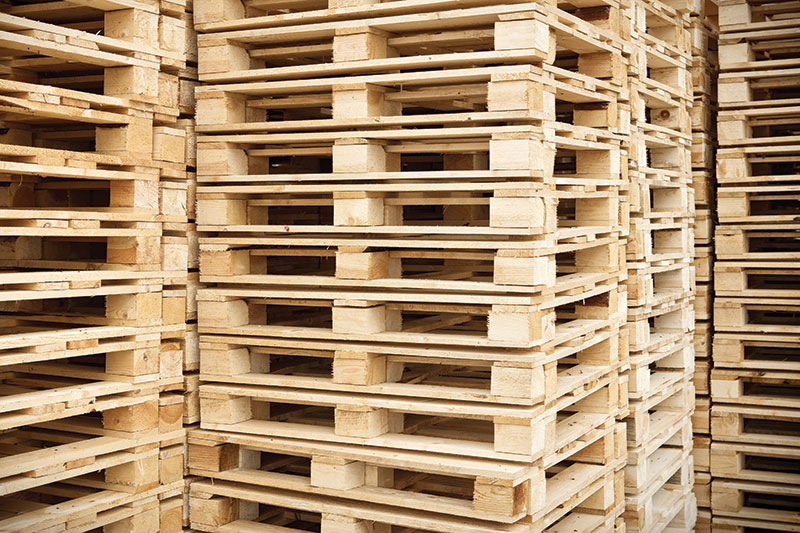
Used to transport finished goods from one place to the next, pallets are a mainstay in most warehouses, DCs, third-party logistics facilities and other fulfillment operations. They help companies consolidate goods onto a single, moveable foundation while also protecting those goods and supporting easier materials handling.
Knowing the important role pallets play in the typical warehouse,Peerless Research Groupconducts an annual pallet usage study on behalf of Modern Materials Handling. Now in its 12th year, the “2022 Pallet Market Evaluation” delves into the current and projected use of pallets in the world’s warehouses and fulfillment centers and highlights the key trends taking place in the pallet market right now.
The study covers the factors considered important when determining which types of pallets to use; what types of pallet companies are currently using or considering for the future; and just how many companies are using new versus used wood pallets.
What types of pallets do you use?
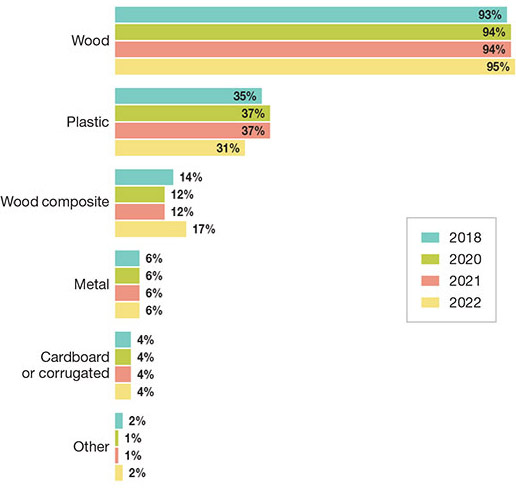
Source: Peerless Research Group (PRG)
Other trends highlighted in this year’s report include plastic pallet usage, planned usage of pallets over the next two years, recent changes to pallet usage patterns, how companies are using pallet rental services, and the usage of pallets outside of United States borders.
Are the wood pallets you purchase new or used?
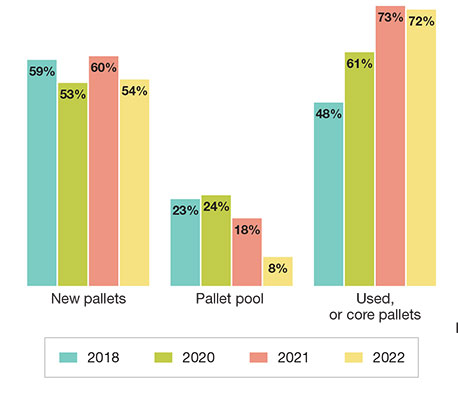
Source: Peerless Research Group (PRG)
The survey was sent by e-mail invitation to subscribers of Modern Materials Handling magazine and is based on input from individuals who work for companies that use pallets. This year’s 161 respondents work in manufacturing (56%), wholesale trade (12%), retail (8%) and various other industries, including food, beverage and tobacco, automotive and transportation equipment, industrial machinery, and chemicals/pharmaceuticals.
The bulk (33%) of respondents are employed by companies with less than $10 million in annual revenues, 19% work for organizations with $10 million to $49.9 million, and 14% are employed by companies with anywhere from $100 million to $499.9 million in annual revenues. Here’s what they had to say about their current and projected use of pallets in 2022.
What has been your experience obtaining used wood pallets?

Source: Peerless Research Group (PRG)
Which best describes your level of usage for used wood pallets?

Source: Peerless Research Group (PRG)
Wood pallets on top
Known for its durability, affordability and recyclability, wood is the material of choice for pallets used in today’s fulfillment centers. According to the survey, 95% of companies are currently using wood pallets, which is consistent with the prior year’s results. Thirty-one percent of respondents say they’re using plastic pallets (down from 37% last year), while 17% use wood composite pallets (up from 12% last year). In addition, 6% use metal pallets and 4% use cardboard or corrugated pallets.
How would you describe your usage of plastic pallets during the last year?

Source: Peerless Research Group (PRG)
When shipping internationally, what do you do that is different from domestic shipments?
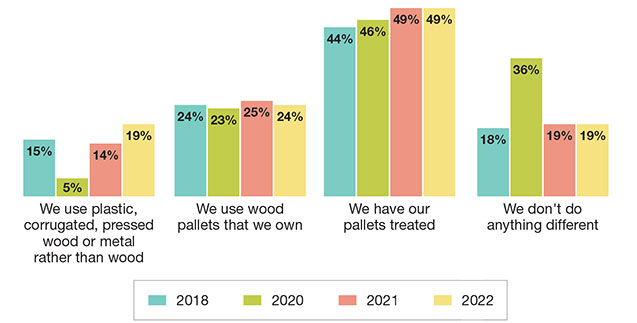
Source: Peerless Research Group (PRG)
During the past two years, how has the number of pallets shipped internationally changed?

Source: Peerless Research Group (PRG)
The most common pallet size is 48 x 40-inch, which is currently being used by 77% of companies. Other pallet sizes commonly found in warehouses and DCs include 48 x 48-inch (for 27% of respondents) and 42 x 42-inch (19%). Because pallets come in a range of sizes to accommodate different types of products and loads, 12% of companies prefer 36 x 48-inch, 7% use half pallets (24 x 20-inch), and 6% commonly use 36 x 36-inch.
Some companies prefer new pallets, others prefer used options and still others take a hybrid approach when selecting pallets. Overall, 54% of companies say they purchase new wood pallets, while 72% acquire used or core wood pallets. About 8% say they use a pallet pool—a percentage that’s decreased from 18% in 2021 and 24% in 2020.
Used pallets are in short supply this year. Of the companies that prefer this option, 56% say fewer pallets are available, 44% say the quality of the used pallets is not as good as new pallets, and 40% say used pallets are more expensive.
The used pallet shortage has exacerbated over the last year, presumably due to the pandemic-related supply chain constraints and disruptions. In 2018 and 2020, for example, 27% of companies were experiencing shortages of used pallets.
About half (51%) of respondents say they are using more used pallets than they did a year ago, while 42% are using about the same amount, and 8% are using fewer used pallets than they were in 2021.
What is the nature of your shipments?
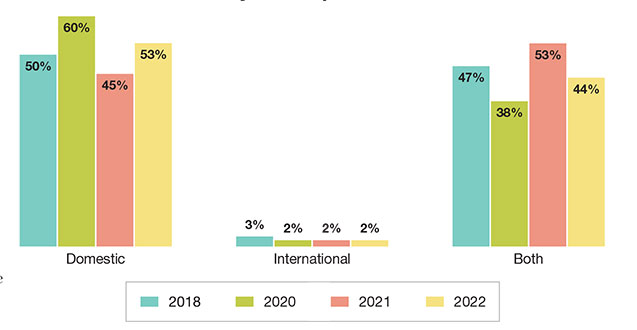
Source: Peerless Research Group (PRG)
Which countries or regions are you shipping?
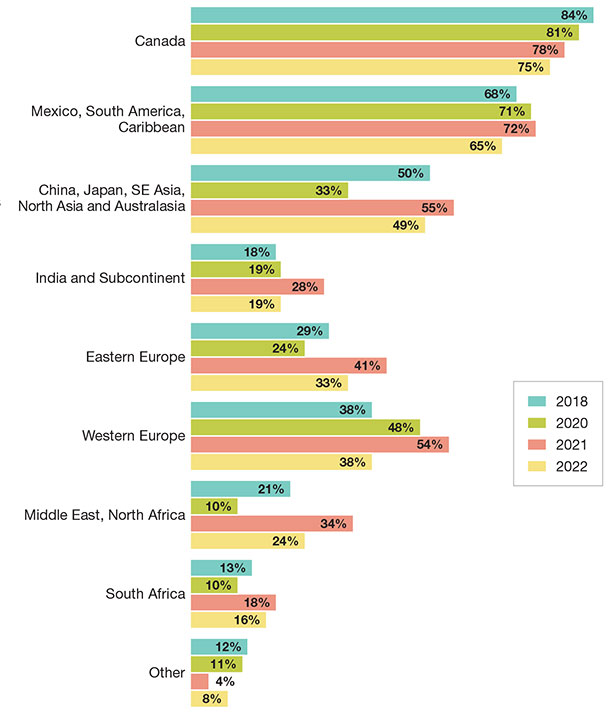
Source: Peerless Research Group (PRG)
Plastic pallets hold steady
Among plastic pallet users, the majority (66%) of companies haven’t changed the number of pallets they’ve used in the last year, while 23% are using fewer plastic pallets and 17% have increased their use of this pallet type.
Over the next 12 months, 60% of respondents expect their plastic pallet usage to remain the same, 19% expect to use more plastic pallets and 18% will use less. Four percent of companies say they will begin using plastic pallets for the first time within the next 12 months.
的公司计划增加塑料的朋友let usage over the coming year, 23% are doing so due to compliance issues, 20% like the durability factor of this pallet type and 20% see this option as being more sustainable than wood pallets. Other companies (15%) plan on using more plastic pallets because customers are asking for them or because it gives them greater control over their pallets (10%).
Who’s renting pallets?
Companies get and retrieve their pallets in different ways. About 12% of respondents use a pallet rental company while 15% use another type of pallet retrieval or recovery system. Seventy-three percent of companies aren’t using these services.
问他们是否愿意考虑一个托盘retrieval, recovery system or third-party pallet rental system within the next year, 27% say that move is either likely or highly likely. Fifty-eight percent of companies aren’t interested in using these third-party services. (Interestingly, 16% of respondents say they don’t even know what these systems are.)
Shipping outside the United States
Fifty-three percent of companies surveyed only manage domestic shipments, while 2% ship strictly internationally and 44% handle both domestic and international shipments.
Of the companies that handle international shipments, most are shipping to Canada (75%); Mexico, South America and the Caribbean (65%); China, Japan, Southeast Asia, North Asia and Australasia (49%).
Over the past two years, 38% of respondents say they have increased their number of pallets shipped internationally, while 53% say the number has stayed the same, and 10% have decreased the numbers of pallets that they ship internationally. Over the next two years, 48% of companies expect the number of pallets they ship internationally to increase, 44% expect the number to stay the same and 8% expect a decrease.
When shipping internationally, companies take extra measures with their pallets, with nearly half (49%) treating their pallets for international shipments and 24% using wood pallets that someone else owns to manage those shipments.
Nineteen percent of companies use plastic, corrugated, pressed wood or metal pallets rather than wood when shipping overseas, and the same percentage say they don’t do anything differently when managing international versus domestic shipments.
你过去使用第三方服务help you to better understand the pallet and transport packaging combination (i.e. stretch wrap, shrink wrap, banding, etc.) best suited to your operation?

Source: Peerless Research Group (PRG)
How interested are you in using a third-party service to help you better understand the optimal pallet and transport packaging combination for your operation?

Source: Peerless Research Group (PRG)
Beyond the basics
Seventeen percent of respondents say they’re using (or have used in the past) a third-party service to help them better understand the pallet and transport packaging combination (i.e. stretch wrap, shrink wrap, banding, etc.) that’s best suited to their operation. In gauging respondents’ interest in using third-parties to handle these services, 38% say they’d be interested in making this move.
托盘供应商提供的不仅仅是托盘。According to the survey, the most popular service is on-site recycling and reclamation process management (for 27% of respondents), while another 26% say their provider offers vendor managed pallet inventory/just-in-time delivery, and 25% say their provider provides backhauls. Providers also offer on-site crate assembly and delivery to the manufacturing line (10%) and data or information related to their supply chain network (9%).
If the services were made available to them, 40% of survey respondents say they would be interested in vendor managed pallet inventory/just-in-time delivery from a third-party pallet provider, and 38% would be interested in on-site recycling and reclamation process management. Also, 21% would be interested in backhauls, 17% want data or information related to their supply chain network, and 13% would like help with on-site crate assembly and delivery to the manufacturing line.
That’s a wrap
Most companies ship and receive corrugated boxes (69%), bags (20%), drums (20%), pails (16%), or plastic totes/RPCs (12%) on their pallets. Twelve percent use flexible intermediate bulk containers (FIBCs), and 34% use some other type of packaging.
这些方法c似乎工作得很好ompanies that deploy them. Most respondents (74%) experience no unit load stability issues in their supply chains, although 26% do struggle with this issue. Of the latter, 29% say they experience those issues monthly, 26% say it happens weekly (down from 42% last year) and 20% say quarterly (up from 8% last year).
When it comes to standardization processes for stabilization, 51% of companies surveyed use some level of standardization, 25% call their processes “highly standardized” and 24% do not use standardization.
What percentage of the packages shipped or received on pallets are the following types?

Source: Peerless Research Group (PRG)
In most cases, unit loads are stabilized using stretch film (65%), shrink film (42%) or strapping/banding (37%). Other companies use stretch hood (13%), interlocking (12%), shrink hood (11%), lock’n pop adhesive (11%) or tie sheets (7%) to stabilize their unit loads when shipping and receiving. Specific to stretch wrapping, 53% of respondents manage the process manually, 27% use automated stretch wrappers and 17% rely on semi- or fully automated stretch wrappers (down from 25% last year).

Article Topics
Pallets News & Resources
The Robotics’ Second Wave Trinchero Family Estates’s Warehouse / DC: Pallet handling in the vineyard XPO Logistics will continue to support the New York City Emergency Management Department Learn Why Stiffer Pallets are Always Better for One-Way Shipping Behind KION Group’s acquisition of Dematic Pallet market set to reach 1.3 billion units in 2017 UPS introduces new offering focused on palletized international heavy air freight More PalletsLatest in Logistics
Breakthrough’s new study focuses on key shipper and carrier goals over the next 12 months DHL expands its presence in Orlando with move into new facility Talking logistics trends and themes with Steve Huntley, President and Owner, Resource Logistics Group U.S. rail carload and intermodal volumes are down, for week ending June 17, reports AAR FTR’s Trucking Conditions Index shows modest improvement while long-term issues remain intact AAR report highlights ways in which railroads can play a key role in facing climate change FedEx finishes FY 2023 with earnings declines, amid signs of improvements More LogisticsSubscribe to Logistics Management Magazine

Find out what the world's most innovative companies are doing to improve productivity in their plants and distribution centers.
Start your FREE subscription today.
June 2023
万博2.0app下载

Latest Resources






